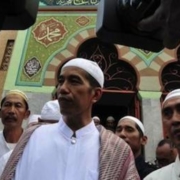
Despite legal progress to prevent child marriage, numbers are climbing during the Covid-19 pandemic. Photo by Arnas Padda for Antara
Indonesia is experiencing a surge in child marriages. By June, 24,000 applications for permission to marry underage had been lodged with district and religious courts this year – more than two and a half times the total number for the whole of 2012.
This escalation goes against significant recent improvements in the legal framework, policies and public campaigns, as well as the government’s stated aim to reduce the prevalence of child marriage from 11.2% to 8.7% by 2024.
Court clerks cite teen pregnancies and last year’s amendment to the 1974 Marriage Law as reasons for the higher number of requests to marry young.
Under the 1974 Marriage Law, the minimum age of marriage was 19 for boys and 16 for girls, provided they had permission from their parents. The 2019 amendments raised the minimum marriageable age for girls to 19, with parental permission, bringing it into line with the minimum for boys (Article 7(1)). However, the revised law still allows parents to ask courts for special dispensation for their children to marry before 19 if there are “pressing reasons” (Article 7(2)).
Many factors drive child marriage in Indonesia. Poverty, education, the stigmatisation of sexuality outside marriage, religious convictions, local perceptions about marriageable age, and even ‘mutual love’ (suka-sama-suka) among teen couples all play a role in rates of child marriage.
The Ministry of Women’s Empowerment and Child Protection has expressed concern that increased economic pressure from Covid-19 may be leading parents to push their children to marry young, to reduce the economic burden on their households. A trend that idealises young marriage, promoted by conservative religious groups and on social media, is another factor.
The Manpower Ministry reported that more than 3.5 million workers had been laid off by 31 July, with the number predicted to rise to 5.5 million by year-end. Indonesia’s poverty rate is expected to increase to 9.7 per cent by September, meaning that 1.3 million more people will be pushed into poverty.
The impacts of this for children are frightening. Unicef predicts that the increase in poverty in Indonesia will worsen child malnutrition, affecting children’s physical and mental development. It will increase the risk of 9.7 million children dropping out of school. Economic decline, combined with lack of formal education, may drive parents to urge their children to marry young, especially girls.
At the same time, Indonesia is experiencing a surge of religious conservatism that is driving a backlash against legal efforts to support gender equality and end child marriage. For example, the ‘Indonesia Without Dating’ (Indonesia Tanpa Pacaran) movement encourages young adults to avoid dating and focus on serving God. It has attracted more than a million followers on Instagram. Its social media content pairs fairy-tale images of romantic love with slogans that encourage young marriage as a way to avoid the temptation of pre-marital relations.
An idealised view of young marriage is also promoted by social media influencers. Sabrina Salsabila, a teenager from West Java who married at 16, has amassed more than 74,000 subscribers on YouTube and more than 133,000 followers on Instagram, where she shares airbrushed images of her glamorous, globetrotting life as a young bride. Despite facing some public criticism, her young followers continue to express their desire to follow her path.
Conservative family values may also be a factor. A study of 61 dispensations for underage marriage in 2017-2018 conducted by students and a lecturer at Gadjah Mada University’s Faculty of Law found that the majority of those marriages were instigated by parents who felt that their children had dated long enough, and were concerned about the potential for pre-marital sex. In cases of teen pregnancy, child marriage was pushed by families as an immediate solution. In other words, some families’ moral values conflict with legal protections against child marriage.
Further, Indonesian family law is a complex patchwork of national, customary (adat), religious, and Dutch colonial laws. While the revised Marriage Law sets a clear minimum age of 19 for boys and girls, and only allows child marriage with court approval, adat and religious laws have their own definitions and guidelines. Although the courts do not recognise them, these alternative legal systems are another cause of the high number of underage marriage applications across Indonesia.
What can be done?
The amendment to the Marriage Law, and a subsequent Supreme Court regulation that provided guidance for judges in deciding marriage dispensation proceedings, were hard-won achievements in the fight to end child marriage in Indonesia. For more than 40 years, through five administrations, the Marriage Law remained unchanged, as lawmakers and politicians avoided the sensitive issue.
If it were not for the efforts of a relentless civil society movement that drafted and promoted amendments to the Marriage Law, and a group of victims of child marriage who filed a judicial review application with the Constitutional Court, these changes would never have happened.
As the government responds to Covid-19, efforts for economic recovery must include assistance to prevent more families falling into poverty, as well as efforts to ensure children’s right to formal education is fulfilled. Further work must be done to provide adequate and sensible sexual and reproductive health education in schools and communities.
Addressing conservative religious and customary values is a much more challenging task. The government cannot rely on top-down, bureaucratic programs to address the issue. Local context matters. The government should facilitate village and religious leaders, parents, teachers and young people to come up with community-based programs to respond to the local situation.
Victims’ stories of child marriage and the impact it had on their lives were compelling for the Constitutional Court when it decided the marriageable age of 16 for girls was unconstitutional. Victims should be provided with more opportunities to tell their stories to their peers, to debunk false images of blissful child marriage.
It is also essential to create a broader and more frequent discourse on child marriage, providing opportunities for conservative groups to sit together with opponents of child marriage. Influencers could also be recruited to spread messages on social media to counter the narrative of conservative groups.
Indonesia has made remarkable progress in improving the legal and policy framework to protect children from child marriage. But as recent figures have shown, policy change is not enough on its own. To prevent further backsliding, a serious effort will be required – and soon.









